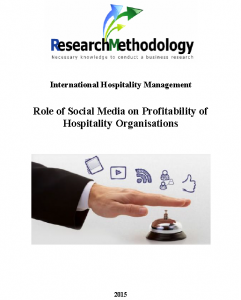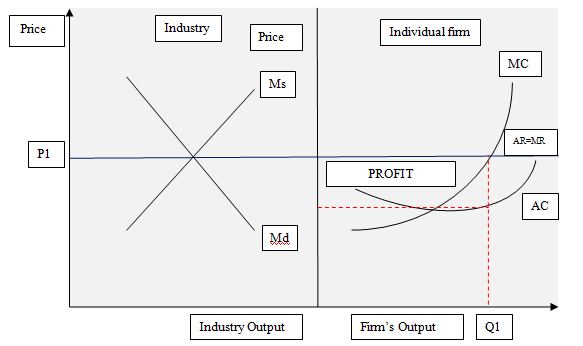Posts by John Dudovskiy

Marketing research can be specified as the main tool to impact consumer behaviour in order to increase the levels of consumer loyalty and achieve long-term growth of the businesses. Marketing research can be divided into the following stages: The first stage is associated with problem definition. Range of marketing research problems related to consumer behaviour may include but not limited to assessment of impacts of prices changes or re-branding initiatives on consumer attitudes, establishing the levels of brand value amongst target customer segment etc. The second stage relates to secondary data collection and analysis. Relevant data available in government publications, statistical information, as well as, findings of previously published marketing research papers can be utilised in an extensive manner during this stage. The third stage in marketing research process refers to collection of primary data. The majority of marketing researches are facilitated through primary data collection and analysis. The most popular methods of primary data collection for marketing research include surveys, focus groups, interviews, storytelling, experiments and observations. Moreover, marketing research can also be conducted with application of conjoint analysis, purchase panels, database marketing and netnography. The fourth stage involves primary data analysis. Data analysis can be qualitative, quantitative or integrated according to the nature of problems being researched. Adoption and maintenance of an objective approach plays important role at this particular stage of marketing research process. The fifth stage is devoted to formulation of recommendations. Specifically, alternative set of recommendations or inter-related recommendations can be offered to senior level management on the basis of primary data analysis. The sixth stage in marketing research process involves selection and implementation of a strategy. In most cases internal or external members of team responsible for conducting marketing research do not engage in implementation of recommendations in practical levels. Therefore, it is important…
By John Dudovskiy
Category: Consumer Behaviour

The topic of consumer behaviour is one of the massively studied topics by the researchers and marketers in the past and still being studied. Researchers show different reasons as to why consumer behaviour has been the topic of many academics and researchers. One of the common views is that understanding consumer behaviour has become a factor that has a direct impact on the overall performance of the businesses (Kotler and Keller, 2012). Another view suggests that understanding consumer behaviour has become crucial especially due to fierce competition in retail industry in the UK and worldwide (Lancaster et al, 2002). This chapter will introduce some other areas of research background of consumer behaviour addressing the works of researchers and marketers. Moreover, consumer decision making process, in particular, five stages of consumer decision making process will be discussed in detail. Introduction It is worth noting that consumer buying behaviour is studied as a part of the marketing and its main objective it to learn the way how the individuals, groups or organizations choose, buy use and dispose the goods and the factors such as their previous experience, taste, price and branding on which the consumers base their purchasing decisions (Kotler and Keller, 2012). One of such studies of consumer buying behaviour has been conducted by Acebron et al (2000). The aim of the study was to analyze the impact of previous experience on buying behaviour of fresh foods, particularly mussels. In their studies the authors used structural equation model in order to identify the relationship between the habits and previous experience on the consumer buying decision. Their findings show that personal habits and previous experience on of the consumers have a direct impact on the consumers’ purchase decision in the example of purchasing fresh mussels. They also found that the image of the…

Motivation, personality and perception belong to the list of central themes in the area of consumer behaviour. Maslow’s Hierarchy of Needs (1943) is one of the most significant theoretical frameworks in the area of human motivation and this theory relates to the study of consumer behaviour in a direct way. Maslow (1943) divides human needs into five layers arranged in a hierarchical manner: psychological, safety, social, and esteem needs. In simple terms, the core idea behind Maslow’s Hierarchy of Needs (1943) can be explained in a way that businesses need to appeal to the most immediate and urgent needs of customers in order to generate sales. For example, an individual who is yet to satisfy his or her safety needs is not motivated to purchase products and services associated with high social status, thus individuals belonging to this category should not be targeted for premium range of products and services. From this perspective, Maslow’s Hierarchy of Needs (1943) is related to segmentation, targeting and positioning practices to a certain extent. Personality represents another important physiological variable with certain implications on consumer behaviour and personality elements or traits include self-confidence, sociability, adaptability, deference etc. In-depth knowledge about important aspects of personalities of target customer segment allows businesses to manipulate with elements of marketing mix in general and promotion element in particular in terms of making an effective appeal. For example, marketing research findings of a premium brand watch manufacturing company may indicate that the majority of representatives of target customer segment are highly ambitious individuals aspiring to top management positions in multinational corporations. This information can be used to impact consumer behaviour by engaging in product placement marketing strategy via displaying the use of the premium watch by highly successful senior managers in various media productions. High levels of subjectivity of…
By John Dudovskiy
Category: Consumer Behaviour

The most popular approaches to consumer behaviour can be divided into cognitive, behaviourist and psychodynamic categories. Cognitive approach to consumer behaviour focuses on information processing capabilities of consumers (Schmitt, 2003). Specifically, according to cognitive approach environment and social experiences provide individuals with abundant information to be processed, and the outcome of information processing results in individuals behaving in certain ways as consumers. For example, individuals may receive information about forecasted economic downturn in a national level and this information can serve as a stimulus to behave in certain manners. Specifically, according to cognitive approach although the forecasted economic downturn has not happened yet, nevertheless consumers may reduce levels of their spending budgets as a response to the stimulus. Behaviourist approach to consumer behaviour, on the other hand, is associated with the impact of external events. Lantos (2010) link this approach to infamous experiments of Russian scientist Ivan Pavlov and these experiments involved developing certain behavioural patterns via external factors. Practical implementation of this approach in the field of marketing can be observed in relation to Nescafe products. Specifically, integrated marketing strategy of Nescafe attempts to foster a specific pattern of behaviour amongst target customer segment whereby consumption of a cup of Nescafe coffee has to be the first thing to do in the morning. Importantly, Loudon et al. (2010) make a clear distinction between cognitive and behaviourist approaches to consumer behaviour in a way that in cognitive approach information from external sources are processed by consumers in apparent manners, whereas in behaviourist approach consumers may not be fully aware of the impact of external environment. Accordingly, Loudon et al. (2010) consider behaviourist approach to be superior compared to cognitive approach in terms of motivating perspective consumers to commit to the purchase. Lastly, psychodynamic approach “includes all theories in psychology that…
By John Dudovskiy
Category: Consumer Behaviour

Competition is becoming intensive for virtually all types of products and services and due to this tendency responsibilities of marketing department of companies have increased. Marketing mix can be specified as an effective framework that can be used to increase the overall value of products and services to customers. This article contains analysis of each element of marketing mix by using a variety of secondary data sources. The notion of marketing mix refers to a balance of marketing methods needed to sell products and services. Marketing mix consists of four core elements – product, price, place and promotion that are jointly known as ‘four Ps’. Extended marketing mix contains additional ‘three Ps’ consisting of people, process and physical evidence. Product element of marketing mix Anything that has a potential to satisfy specific customer needs can be specified as product. In modern marketplace learning about customer needs and wants through marketing research precedes development of products and services. Product variables include but not limited to its design, durability, technical features and capabilities, ease of maintenance and others. Businesses use branding in order to differentiate their products and services from other products and services offered in the market. For example, while there is a wide range of soft drinks offered in the market, Coca-Cola drink in particular has a large market share, partially due to successful branding strategy of the company. Importantly, benefits of successful branding go beyond any particular single product to assist the sales of other products offered by the company as well. Positive image of Apple brand assists sales of MacBook desktop computers, as well as, other products offered by the company such as IPhone and IPad. Benefits of products and services have tremendous on the levels of revenues and these benefits can be divided into three categories:…

This article represents a critical analysis of marketing communications materials used by Coca-Cola Company, a global beverage manufacturer and retailer based in Georgia, United States. The Coca Cola Company is a global manufacturer, marketers and seller of non-alcoholic beverages and syrups based in Atlanta, US. Range of brands owned by the company includes Coca-Cola, Diet Coke, Coca Cola Zero, Sprite, Fanta, Powerade, Minute Maid, Aquarius, Dasani, Schweppers and others. This article focuses on marketing communication materials associated with one of its core products, the Coca-Cola drink. Established in 1886, the company currently sells in more than 200 countries and beverage trademarks owned and licensed by the company account for 1.9 billion of approximately 57 billion beverage servings around the globe on a daily basis (Annual Report, 2013). The article starts with description and analysis of various types of media employed in order to promote the Coca-Cola, followed by the identification of objectives of Coca-Cola campaign. Then, extensive analysis of images and words used in Coca-Cola campaign is undertaking in order to ensure a greater scope for the current research. Moreover, attempts are made to analyse the appeal of Coca-Cola marketing messages, as well as, assessments are provided at what extent Coca-Cola marketing campaigns were achieving their objectives. Types of Media used to Promote Coca-Cola Media can be defined as a “facilitating institution who suggest appropriate message within the operative constraints of space” (Tyagi and Kumar, 2004, p.341) and is considered to be one of the most effective advertisement methods among marketing practitioners. Spurgeon (2008) divides media into two categories: published media and visual/aural media. Published media includes newspapers, magazines, trade and professional press, as well as internet. Visual and aural media, on the other hand, include television, radio, cinema, posters, billboards, and direct mailing. Various types of media are used…

The 21st century has been dubbed as an information age (Bell and Blanchfower, 2011) and internet in general, and social media in particular are playing an instrumental role in facilitating the spread of information throughout the globe at a rapid speed. Moreover, increasing levels of interactivity of social media platforms is further contributing to the level of their popularity, and nowadays social media has been effectively adopted by many businesses along a wide range of industries as a highly effective marketing and communication platform. At the same time, the level of use of social media varies between various industries, as well as, individual organisations within a particular industry, and while some organisations are beginning to realise substantial opportunities offered by social media, others are already utilising these opportunities to a full extent. This essay contains a critical evaluation of the role of social media on the popularity of a tourism destination. The essay starts with discussions about increasing influence of social media on consumer behaviour. This is followed by critical analyses of potential benefits of social media to hospitality organisations. Moreover, issues related to negative impacts of social media on the performance of hospitality organisations are also addressed in this essay. Essay is concluded by providing a set of recommendations to strategic and marketing managers of hospitality organisations in terms of benefiting from opportunities offered by social media to a maximum extent. Introduction 1 Increasing influence of social media on consumer behaviour in service sector 2 Potential benefits of social media to hospitality organisations 5 Negative impacts of social media on the performance of hospitality organisations 8 Recommendations for managers of hospitality organisations in relation to social media 10 Conclusions 14 References 16 Cathay Pacific DoubleTree Club Hotel Facebook Hampton Hotels Twitter How do I receive the report? Once payment…

Pure monopoly refers to a situation where there is only one firm offering a specific type of product or service. However, instances of pure monopoly are very rare in modern markets due to the intensified level of globalisation of economies and anti-monopoly rules and regulations introduced by governments. Working monopoly refers to a situation where any company possesses more than one fourth of the market share. Certain firms are able to attain monopoly in the market due to possession of scare resources, special government grants under certain circumstances, possession of patents for innovations or as a result of merger of two or more large companies in the industry. Achievement of profit maximisation objective is easier by monopolistic firms compared to other market structure due to the lack of competition. In simple terms, consumers have no choice but to purchase products offered by monopolist firm due to the lack or even absence of alternative products in the market. Price discrimination can be divided into three categories: first degree, second degree, and third degree. First degree price discrimination is associated with inelastic markets where a certain business entity is in the position of pricing its products at different levels, at the same time selling to the whole market without competition, which is rare in practical levels. As it is illustrated in figure below, second degree price discrimination relates to elastic market where businesses offer different amounts of their products for different prices. Lastly, the third degree of price discrimination marks the case of combined market where different prices are set for different groups of consumers. Businesses can engage in price discrimination only if they possess certain degree of monopoly. In other words, monopolistic businesses use price discrimination strategies in order to increase the levels of abnormal profits. The degree of price discrimination…

Perfect competition can be defined as a situation “in an industry when that industry is made up of many small firms producing homogeneous products, when there is no impediment to the entry or exit of firms, and when full information is available” (Baumon and Blinder, 2011, p.200). Market structure can be specified as perfect competition if the following conditions or assumptions are met: Firstly, there are many supplies in the market and each supplier has an insignificant market share. In other words, no single supplier is in the position of impacting price through manipulations with its supply of products. Secondly, there are no major differences between products offered by suppliers and these products can be consumed as substitution for each-other. To be more specific, even when there are certain differences between products in the same industry, they are identical in consumer perception. Thirdly, consumers are fully aware about costs charged by all suppliers. This situation has implications in a way that a certain supplier decides to increase its prices; the levels of its revenues will decline because of consumers switching to other suppliers. Fourthly, the level of access to various resources is equal for all suppliers. Moreover, all participants in the industry can benefit from breakthroughs and other positive changes in the industry in an equal manner. Fifthly, industry entry and exit barriers for suppliers are insignificant. In other words, new suppliers can join competition at any time with implications on the levels of profits of existing suppliers. Sixthly, there is no divergence between private costs and social costs, as well as, benefits due to the absence of externality in manufacturing and consumption. Six main assumptions associated with perfect competition market structure discussed above have certain implications on profit maximisation attempts of businesses. Outcome of interaction between supply and demand…

Burke (2012) links the impacts of the global economic crisis of 2008-2010 with spending cuts on education system by the UK government. Chalabi and Arnett (2013), on the other hand, make an interesting observation related to the issue. Specifically, according to Chalabi and Arnett (2013), the levels of GDP in the UK decreased by 2 per cent between 2008 and 2010, whereas the levels of public expenditure on education have increased by 8 per cent during the same period. A large-scale survey conducted by Education Institution (2009) has attempted to assess impacts of the global economic crisis on education in 48 countries, including the UK. Infrastructure, human resources (HR), and other needs of the UK education system have been found as a result of the survey. Infrastructure needs of UK education system, according to Education Institution (2009) relates to necessity to rebuilt primary schools. Other needs are found to relate to funding for high quality continuing professional development of teachers and challenges associated with reforming curriculum and qualification system. However, it is important to note that Education Institution (2009) findings only relate to education in public sector, and the level of relevance of data to private sector educational institutions are yet to be established. Burke (2012) considers dramatic reduction of numbers of graduate employment schemes offered by multinational companies in 2009 as the direct impact of the global economic crisis. Although, this argument appears to be convincing, Burke (2012) fails to back-up the claim through referring to relevant statistical data. Vaitilingam (2010) points to the risk of lifetime earning loss for a generation of graduates that join full-time workforce during or immediate aftermath of recession. According to Vaitilingam (2010), this situation may occur due to rapid increase in the supply of graduates compared to jobs caused by cuts on graduate…
